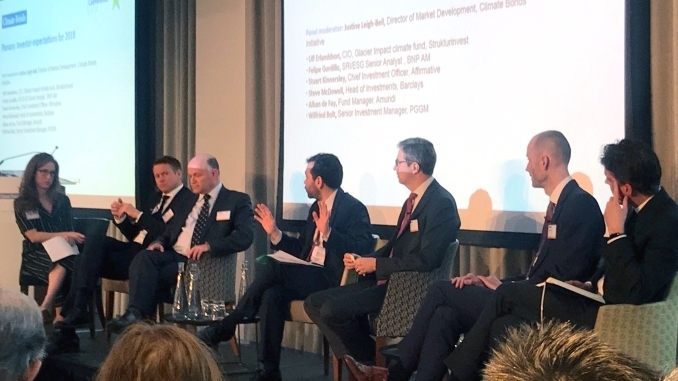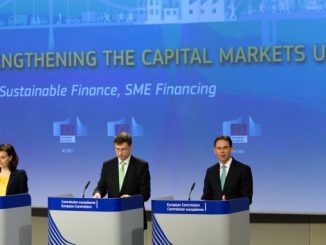
An SRI portfolio manager warned issuers who are slow to take up green bonds that their credentials may be questioned, at CBI18 last Tuesday, although investors said they acknowledge there is no such thing as the perfect green bond, and one said he would commit to buy non-green issuance from other parts of green bond issuers’ capital structure.
“Currently there is an opportunity for issuers to issue green bonds, because we are very happy to see newcomers,” said Alban de Fay, SRI portfolio manager at Amundi. “But next year the question will be, why does this issuer not issue green bonds?
“So pay attention: there is an opportunity for issuers to issue green bonds. But if you wait too long, maybe our confidence regarding your ability to issue green bonds will decrease.”
However, de Fay and other buyside panellists at the Climate Bonds Initiative conference said they are willing to engage with issuers who may be at different stages of making or contributing to the low carbon transition.
“We started investing in green bonds in 2013, 2014, and I sat in a conference very like this, trying to figure out what green bonds were, and thinking, they’re really easy, aren’t they?” said Steve McDowell, head of investments in Barclays’ treasury. “It turns out they aren’t. The point is, I was actually looking for the perfect green bond, and the answer is, there isn’t one.
“You are going to have to accept that whether you are talking about transition or additionality, generally speaking green bonds are not going to be perfect on day one. But I think that’s fine, because we need to start somewhere.”
Wilfried Bolt, senior investment manager, PGGM Investments, echoed this.
“A green bond per se is not changing the world, because it’s a refinancing tool,” he said. “But it signals the intention of the issuer regarding its climate policy, and it’s the starting point of an engagement, a discussion with the issuer.”
Felipe Gordillo, SRI/ESG senior analyst, BNP Paribas Asset Management, cited the example of a Repsol bond that had sparked debate over its green credentials due to the company’s major oil business.
“It may not be a green bond, because it is not about long term solutions,” he said. “But, I think that the most interesting part would be to see those brown companies moving into a pathway in terms of carbon reduction.”
Gordillo said that an interesting example is in Asia, where the ASEAN Capital Markets Forum has, alongside a green label, established a transition label. He said that such issuance should be “very strict and very challenging”, requiring issuers to go above and beyond minimum standards that may already be expected of them.
“If you are going to reduce carbon emissions using, for example, gas, then if the IEA says your sector should be reducing 3% every year, you should go for 5% every year,” said Gordillo. “It is the only way we are able to ensure an integrity for this kind of bonds.
“We have to be very pragmatic,” he added. “We have to make room for both solutions – the long term solutions and the transition solutions.”
BNP Paribas AM is currently seeding a new emerging green bonds fund, Gordillo told Sustainabonds.
“So we are very happy to engage with institutional asset owners who are interested in supporting green finance,” he added.
Ulf Erlandsson, CIO, Glacier Impact climate fund, Strukturinvest, said he is very concerned about the lack of pressure meanwhile being brought to bear on brown assets.
“The problem we’re having in the fixed income markets and in financial markets in general is the amount of capital that is actually going into the brown part of the capital structure,” he said. “As a hedge fund, Glacier Impact will be able to go long and short – for us there is a massive opportunity not only in terms of doing things on the green side, but actually being able to short some of the brown assets out there.
“They are extremely cheap to finance today,” he added. “Look at the cost of capital if you are raising debt if you are an oil major, for example: with European bond curves, you’ll be paying 8bp-9bp over swaps on the 10 year point. As long as we’re seeing that the cost of capital for such brown types of activities being so low, we’re not going to be able to transition at the pace we want to. So the green part of it is fantastic, but there is much more awareness needed within the institutional investor landscape when it comes to the brown part of debt.”
And as part of efforts to work on both sides, Erlandsson said his fund will go beyond simply investing in issuers’ green bonds.
“One idea that we are going to execute in our fund is that we will be invested in the green bond from issuers that we like, but at the same time we are looking to commit to actually buying other parts of the capital structure at the same time,” he said. “So when you come with a green bond, we will be buying other things in your capital structure, as a pre-programmed green halo effect to give issuers the incentive to bring supply to the market.
“Now, we will do that using the borrowed capital which we will raise by shorting brown assets. In sum, this becomes a trade on shifting the cost of debt between green and brown assets, which must be – we argue – at the core of a climate-focused investment strategy. At the same time, it offers CFOs a clear example of, and arguments for, the benefits of issuing green bonds, which should be good for the whole green bond market.”
Photo credit: Chrissa Pagitsas @ChrissaPagitsas/Twitter



